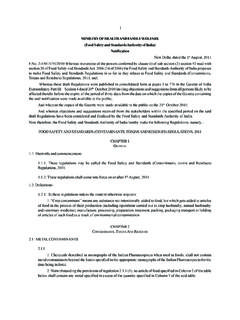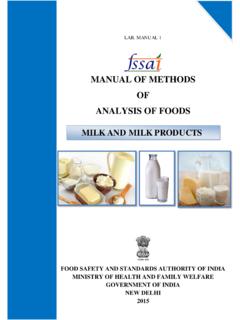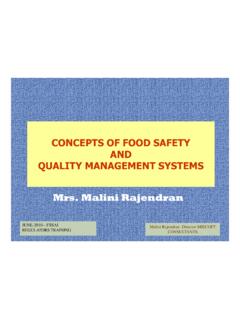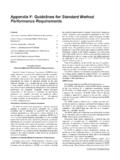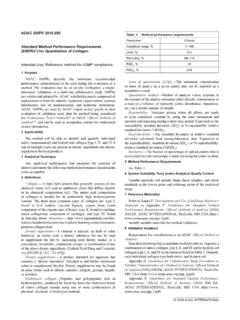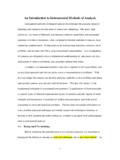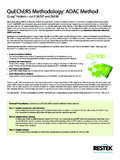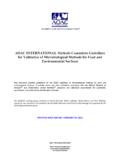Transcription of MANUAL OF METHODS OF ANALYSIS OF FOODS …
1 MANUAL OF METHODS OF ANALYSIS OF FOODS MYCOTOXINS food SAFETY AND STANDARDS AUTHORITY OF INDIA MINISTRY OF HEALTH AND FAMILY WELFARE GOVERNMENT OF INDIA NEW DELHI 2016 MYCOTOXINS 2016 MANUAL FOR METHODS OF ANALYSIS OF MYCOTOXINS TABLE OF CONTENTS TITLE/METHOD PAGE NO. Aflatoxins 4 Safety Requirements for handling mycotoxins 5 Preparation of Sample (a) Lot Sample 6 (b) Laboratory Sample 6 Preparation of Standards for Aflatoxin 6 Preparation and storage of Working Standards 7 Determination of Aflatoxins CB Method 7 Determination of Aflatoxins BF Method 10 Determination of Aflatoxins Romer Mini column method 11 Determination of aflatoxin - Liquid chromatographic method 13 Determination of Aflatoxin M 1 in Milk Cheese and Khoya 18 Determination of Aflatoxins B1, B2, G1 & G2, in Spices, tea, coffee, nutmeg and Rice by HPLC-MSMS 20 Determination of Aflatoxins B1, B2, and G1 in Corn, Cottonseed, Peanuts.
2 And Peanut Butter by Enzyme-Linked Immunosorbent Assay 25 Determination of Total Aflatoxins (B1, B2, and G1) in Corn By Enzyme-Linked Immunosorbent Assay Method 31 Determination of Aflatoxin in corn and peanuts by Thin Layer Chromatographic Method 32 Determination of Aflatoxins M1 and M2 in Fluid Milk By Liquid Chromatographic Method 35 Determination of AflatoxinM1 in Liquid Milk By Immunoaffinity Column chromatography followed by 39 MYCOTOXINS 2016 2 Liquid Chromatography Determination of Deoxynivalenol in Wheat 44 Patulin 47 Determination of ochratoxin in barley 51 Determination of Aflatoxins B1, B2, G1.
3 And G2 in foodstuffs other than those described above 56 References 62 Note: The test METHODS given in the manuals are validated/ standardized test METHODS . However, it would be the responsibility of the respective testing laboratory to confirm that the above METHODS are validated in its laboratory and gives proper result in their laboratory. MYCOTOXINS 2016 3 MANUAL FOR ANALYSIS OF MYCOTOXINS Mycotoxins are metabolic products of fungi, which are capable of producing acute or chronic toxic effects ( carcinogenic, mutagenic, and teratogenic) on animals and probably on men at the levels of exposure.
4 Toxic syndromes, resulting from the intake of mycotoxins by man and animals, are known as mycotoxicosis. Although mycotoxicosis cause by mould Claviceps purpurea have been known for a long time. Mycotoxins remained neglected until the discovery of Aflatoxins in 1960. Mold growth in FOODS is very common, especially in warm and humid climates. It can occur in fields or in storage after harvest. Mould infection of FOODS such as grains, seeds and nuts is often localized in pockets, especially in bulk storage and warehouses Currently a few hundred mycotoxins are known, often produced by genre, Aspergillus, Penicillium and Fusarium.
5 The chemical structures of some important mycotoxins are shown in Figure 1. Figure 1 Chemical structures of a few mycotoxins MYCOTOXINS 2016 4 AFLATOXINS Aflatoxin is probably the most common and widely known mycotoxin contaminant. It is produced by the moulds, Aspergillus flavus and Aspergillus parasiticus. In fact the name is a composite word derived from A. flavus toxin . FOODS that are commonly affected include all nuts, especially groundnuts, tree nuts such as pistachio and Brazil nuts, cottonseed, copra, rice, maize, wheat, sorghum, pulses , figs and oilseed cakes.
6 Unrefined vegetable oils made from contaminated seeds or nuts usually contain aflatoxin. However aflatoxin is destroyed in the refining process so that refined oils are safe. There are six aflatoxins of analytical interest (Figure 2). Four occur in FOODS and two as metabolites in the milk of animals who have been fed contaminated feed. Figure 2: Chemical structure of the six aflatoxins Aflatoxin B1, B2, G1, and G2 refer to toxins which fluoresce blue (B) or green (G) under ultraviolet light and are separable by thin layer chromatography (TLC). The only structural difference between B and G toxins is the inclusion of an oxygen in the cyclopentanone ring.
7 Aflatoxin M1 and M2 represent the toxin B1 and B2, which have been MYCOTOXINS 2016 5 metabolized within the body of a lactating animal. Their finding in milk led to their designation as M . The obvious structural difference between B and M is the addition of the hydroxyl group. The analytical METHODS for aflatoxin include thin layer chromatography (TLC), High performance liquid chromatography (HPLC), and enzyme-linked immunosorbent assay (ELISA). TLC has been most widely used method. Aflatoxins are extremely potent carcinogens in many animals. Aflatoxins are subject to light degradation.
8 Therefore, all analytical materials must be adequately protected from light and standard aflatoxin solutions stored using amber colored vials or aluminium foil. Safety requirements for handling mycotoxins All food samples suspected of being contaminated with mycotoxins must be handled with care. Use disposable gloves and protective masks if grinding the food creates dust. Aflatoxins are potent carcinogenic substances. While handling pure aflatoxin reference material, extreme precautions must be taken as they are electrostatic. All work must preferably be carried out in a hood.
9 Swab any accidental spill of toxin with 1% sodium hypochlorite bleach (NaOCl), leave 10 minutes and then add 5 % aqueous acetone. Rinse all glassware exposed to aflatoxin with methanol, add 1% sodium hypochlorite solution and after 2 hours add acetone to 5 % of total volume. Let it react for 30 minutes and then wash thoroughly. Use a laboratory coat or apron soaked in 5% sodium hypochlorite solution over night and washed in water. Reactive vapours O2, SO2, HCl can affect adsorbents used in TLC as well as the stability of adsorbed spots. TLC must, therefore, be performed only in a laboratory free of volatile reagents.
10 Always dry TLC plates thoroughly before exposure to UV light. UV light from sunlight or fluorescent lamps can catalyse changes to compounds being examined when exposed on adsorbent surface, particularly in the presence of solvent. Avoid exposure to UV light of underdeveloped spots and expose developed plates to UV light for the minimum time needed for visualization. Protect analytical material adequately from light and keep aflatoxin standard solutions protected from light by using amber vials or aluminium foil. Put a warning note on the label. Use of non acid washed glassware for MYCOTOXINS 2016 6 aflatoxin aqueous solutions may cause loss of aflatoxin.
